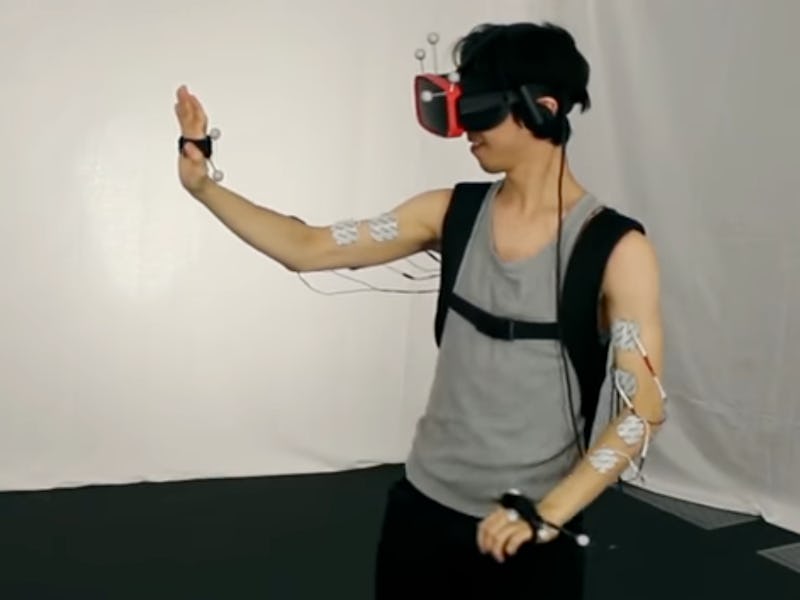
What happens when you walk into a wall in virtual reality? In a new research project from the Human Computer Interaction Lab at the Hasso Plattner Institute in Germany, you get zapped by an electric shock. Researchers recently introduced the ability to simulate weight and physical resistance in virtual reality, using a system of electric haptic feedback.
Rather than simply showing the user a rendered version of their world, the new VR system lets users push against walls and buttons, and even pick up objects to feel their weight. With just a few electrodes and some extra computing power, the team turned a consumer VR setup into something like a primitive Star Trek holodeck.
The system works by tracking the user’s limbs through the virtual environment and, when needed, activating a series of small electrodes placed on specific places around the user’s upper body. If a user pushes against a wall, the system will send a mild electric current through whichever combination of hand and arm muscles they use, simulating the feeling of pushing against that wall. When a user’s hand reaches the nonexistent surface of an object, these electrodes cause the muscles to contract as though they were encountering resistance, but the reality is that the muscles are creating that resistance.
Most exciting is that the stimulation isn’t all or nothing, but can be modulated to produce different levels of resistance for stationary objects and, even better, different perceived weights for objects that can be picked up and moved around.
The researchers figured out that they could create the appropriate feeling of weight by activating the muscle that acts in opposition to the muscle that should be doing the VR work. So, if a players want to bicep-curl an ammo crate, this system represents that feeling by stimulating the tricep to act in opposition to the bicep. The whole thing is controlled by a backpack worn by the user and hooked to up to eight electrodes strategically places around the body.
One interesting wrinkle came when the researchers tried different patterns of stimulating impulses through the electrodes, to see what approach worked best. “We realized that if we let you just feel a short pulse for 300 milliseconds, you won’t even know where it’s coming from, but your muscles will react,” researcher Pedro Lopes tells Fast Company, “because it’s so brief, there’s no way you can rationalize it.” These short bursts gave the team far better outcomes than they had managed in tests of a similar idea, several years ago.
The backpack and electrodes will certainly need to be streamlined if this technology is ever to make its way into the consumer market. But it’s not impossible — neural electrodes have spandex skullcaps to hold them tightly to the scalp, so why couldn’t gamers have spandex VR suits that keep a system of electrodes lined up with their most important muscles?
The Hasso-Plattner team said that one downside of their work is that users tend to become numb to the effects electrodes over time — but don’t worry, since there are a multitude of ways that companies are trying to introduce force feedback (or “haptic feedback”) into VR. The There’s the HaptX suit’s more mechanical approach, and the classic 360 treadmill.
The ultimate VR experience would include both the ability to truly move through a physical space, as in this electrode setup, and also confine the user in a smaller space than they perceive themselves to be in, as with illusory steps on a treadmill. The Star Trek holodeck works this way, allowing crew members to actually move through the room to an extent, but also using force fields to push them around without their knowledge. In this way, people can feel themselves really moving through space, while also being able to move long distances without actually leaving a confined room.